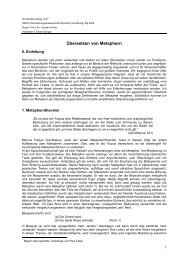Current Opinion in Investigational Drugs
Current Opinion in Investigational Drugs
Current Opinion in Investigational Drugs
You also want an ePaper? Increase the reach of your titles
YUMPU automatically turns print PDFs into web optimized ePapers that Google loves.
18<br />
Editorial overview<br />
Steroid therapy for exudative age-related macular degeneration: Bridg<strong>in</strong>g<br />
the gap until a cure is found<br />
Maneli Mozaffarieh & Andreas Wedrich*<br />
Address<br />
Department of Ophthalmology<br />
Medical University of Graz<br />
Auenbruggerplatz 4<br />
A-8036 Graz<br />
Austria<br />
Email: andreas.wedrich@meduni-graz.at<br />
* To whom correspondence should be addressed<br />
<strong>Current</strong> <strong>Op<strong>in</strong>ion</strong> <strong>in</strong> <strong>Investigational</strong> <strong>Drugs</strong> 2006 7(1):18-19<br />
© The Thomson Corporation ISSN 1472-4472<br />
Age-related macular degeneration (AMD) is a devastat<strong>in</strong>g<br />
disease affect<strong>in</strong>g <strong>in</strong>dividuals of over 50 years of age, and is<br />
the lead<strong>in</strong>g cause of irreversible bl<strong>in</strong>dness <strong>in</strong> the developed<br />
world [1,2]. It is estimated that 1.6% of the population <strong>in</strong> the<br />
50- to 65-year-old age group is affected, and <strong>in</strong> the UK there<br />
are 16,000 new cases per year. The implications of this<br />
untreatable disease <strong>in</strong> terms of social impact, healthcare<br />
costs and personal misery are considerable. <strong>Current</strong><br />
treatments for both the wet and dry forms of the disease are<br />
of limited efficacy [3], and, therefore, there is keen <strong>in</strong>terest<br />
among scientists and physicians to develop new therapies.<br />
Corticosteroids have long been the cornerstone of ocular<br />
anti-<strong>in</strong>flammatory therapy. In addition, they can suppress<br />
cell proliferation. Consequently, steroids have been used for<br />
the treatment of several ocular diseases, adm<strong>in</strong>istered either<br />
locally or systemically. In recent years, one particular<br />
steroid, triamc<strong>in</strong>olone acetonide, has received much<br />
attention from scientists. Various researchers studied the<br />
possibility of <strong>in</strong>ject<strong>in</strong>g this corticosteroid directly <strong>in</strong>to the<br />
eye, firstly <strong>in</strong> animals [4,5] and later <strong>in</strong> selected patients. The<br />
<strong>in</strong>travitreal use of this corticosteroid ga<strong>in</strong>ed popularity<br />
amongst ophthalmologists for the treatment of a wide range<br />
of ret<strong>in</strong>al diseases, <strong>in</strong>clud<strong>in</strong>g diabetic and cystoid macular<br />
edema and exudative AMD.<br />
Steroids, along with the majority of other drugs, do not exert<br />
solely beneficial effects. One common side effect is the rise of<br />
<strong>in</strong>traocular pressure (IOP) that is associated with steroid use.<br />
This issue was addressed <strong>in</strong> a study where a group of<br />
known steroid responders were treated with four different<br />
steroids topically [6]. The results of this study showed that<br />
IOP did not beg<strong>in</strong> to <strong>in</strong>crease until after 3 and 5 weeks of<br />
treatment. The beauty of this f<strong>in</strong>d<strong>in</strong>g for ophthalmologists<br />
was that <strong>in</strong> the worst-case scenario, there rema<strong>in</strong>s a 3-week<br />
w<strong>in</strong>dow of relative safety when treat<strong>in</strong>g with a topical<br />
ophthalmic corticosteroid. Moreover, almost all patients<br />
with primary-care conditions respond to treatment <strong>in</strong> less<br />
than 2 weeks when the steroid is applied topically.<br />
Therefore, should we be concerned about the risk of IOP<br />
elevation after triamc<strong>in</strong>olone acetonide <strong>in</strong>travitreal use for<br />
exudative AMD? Furthermore, do we <strong>in</strong>crease the chances<br />
of improved vision for patients <strong>in</strong> the long term when<br />
<strong>in</strong>ject<strong>in</strong>g this steroid through the <strong>in</strong>travitreal route? The<br />
results of some of the research that has been conducted <strong>in</strong><br />
this area show that even 4 mg of <strong>in</strong>travitreal triamc<strong>in</strong>olone<br />
significantly raises IOP [7,8]. In one particular study, the<br />
researchers describe us<strong>in</strong>g 25 mg of triamc<strong>in</strong>olone for<br />
<strong>in</strong>travitreal <strong>in</strong>jections [9], which may <strong>in</strong>crease IOP even more<br />
significantly. The <strong>in</strong>vestigators suggested that the advantage of<br />
a higher dose would be the longer <strong>in</strong>traocular availability of the<br />
drug [10], rather than the temporary visual improvements<br />
encountered <strong>in</strong> patients after <strong>in</strong>travitreal <strong>in</strong>jections [8], despite<br />
the possible side effects. It appears that our scientific<br />
enthusiasm for possible visual improvements <strong>in</strong> exudative<br />
AMD with steroid <strong>in</strong>jections has forced us to step sideways.<br />
Indeed, various studies suggest that <strong>in</strong> exudative AMD, the<br />
modes of action of triamc<strong>in</strong>olone are l<strong>in</strong>ked to the<br />
downregulation of <strong>in</strong>flammatory markers and endothelial<br />
cell permeability [11,12]. However, moderate-to-high<br />
concentrations of this drug would be required at the site of<br />
action <strong>in</strong> order to prevent further growth of subret<strong>in</strong>al<br />
neovascular tissue. For patients, this requirement would mean<br />
that triamc<strong>in</strong>olone must be <strong>in</strong>jected repeatedly, otherwise visual<br />
improvements would only occur <strong>in</strong> the short term [8]. The<br />
question that then arises is up to how many <strong>in</strong>travitreal<br />
<strong>in</strong>jections of this steroid can be tolerated by the eye of each<br />
patient? Unfortunately, most of the research that has been<br />
conducted <strong>in</strong> this area to date has not been associated with a<br />
long enough follow-up time, one of the longer follow-up times<br />
be<strong>in</strong>g 18 months [7]. We therefore do not have a fair idea of the<br />
actual long-term outcome (ie, visual improvement or the side<br />
effects of this drug), particularly when <strong>in</strong>ject<strong>in</strong>g via the<br />
<strong>in</strong>travitreal route more than once.<br />
Another concern when us<strong>in</strong>g <strong>in</strong>travitreal steroids is the<br />
association of steroid use with an <strong>in</strong>crease <strong>in</strong> lens opacity. In<br />
one particular study <strong>in</strong> which <strong>in</strong>travitreal <strong>in</strong>jections of<br />
triamc<strong>in</strong>olone were adm<strong>in</strong>istered for the treatment of diffuse<br />
diabetic macular edema [13], a 3-fold <strong>in</strong>crease of the posterior<br />
subcapsular cataract score among phakic patients occurred.<br />
This trend toward cataract progression suggests that cataract is<br />
a likely risk of steroid <strong>in</strong>jections. Cataracts <strong>in</strong>fluence quality-oflife<br />
measures [14], and therefore a delay of cataract onset could<br />
have a tremendous <strong>in</strong>fluence on the health of patients and on<br />
healthcare costs. The issue of cataract progression is also of<br />
particular <strong>in</strong>terest for patients with AMD, because there is<br />
controversy regard<strong>in</strong>g the possible benefits or risks of cataract<br />
surgery <strong>in</strong> these patients. While some reports suggest that<br />
cataract surgery may worsen the progression of AMD [15,16],<br />
others describe a benefit [17,18]. It may therefore be more<br />
justified to resist the temptation to treat patients with multiple<br />
<strong>in</strong>travitreal steroid <strong>in</strong>jections as there is currently no evidence<br />
of long-term benefits and, by <strong>in</strong>creas<strong>in</strong>g the chances of<br />
cataracts, patients may become more vulnerable to possible<br />
side effects after surgery.<br />
A further side effect of corticosteroid <strong>in</strong>jections is steroid<strong>in</strong>duced<br />
<strong>in</strong>fection [19,20]. Some researchers have reported

















